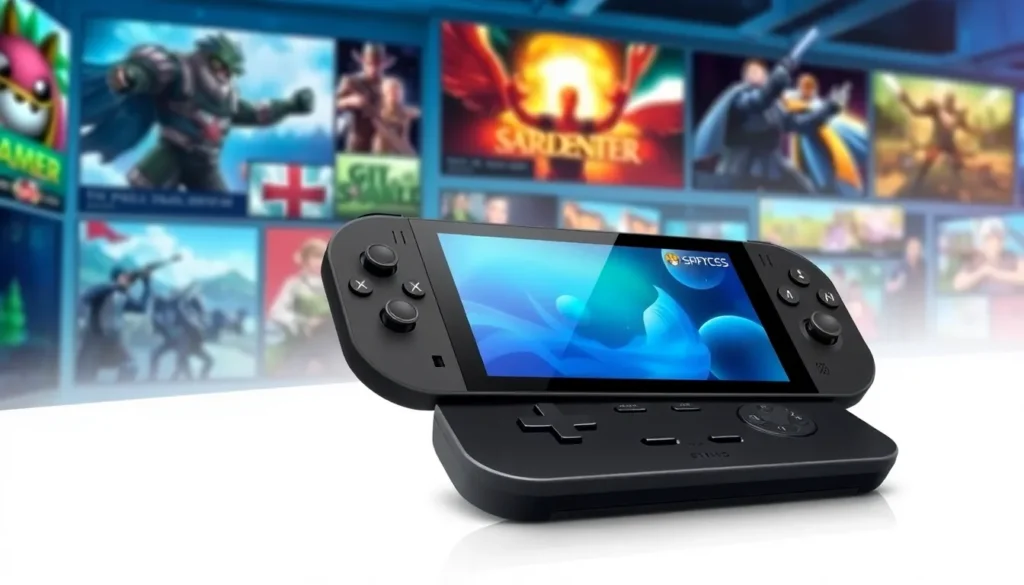In the world of handheld gaming, the Steam Deck has burst onto the scene like a caffeinated raccoon at a picnic. Gamers everywhere are itching to know how its graphics stack up against the competition. Is it a pixel powerhouse or just a glorified toaster? This article dives into the nitty-gritty of Steam Deck’s graphics performance, comparing it to other popular devices to see if it can hold its own.
With a sleek design and the ability to run PC games on the go, the Steam Deck promises an experience that’s hard to resist. But does it deliver in the graphics department? Join the adventure as we explore frame rates, resolution, and everything in between, all while keeping it light and entertaining. Get ready to find out if the Steam Deck is the handheld hero gamers have been waiting for or just another wannabe in the gaming galaxy.
Table of Contents
ToggleOverview of Steam Deck Graphics
Steam Deck’s graphics performance stands out in the handheld gaming market. The device leverages AMD’s custom RDNA 2 architecture, enabling it to deliver impressive visuals. Gamers can experience a resolution of up to 1280 x 800 pixels, providing clarity across various titles. Frame rates frequently reach 60 FPS, depending on the game and settings used.
Graphics settings can be adjusted, allowing players to find a balance between visual fidelity and performance. Many AAA titles run smoothly with medium to high settings, illustrating the Steam Deck’s capabilities. Noteworthy examples include “The Witcher 3” and “Doom Eternal,” both displaying detailed environments and fluid animations.
Additional features enhance the gaming experience. AMD’s FSR technology improves performance by upscaling lower resolutions. This results in better graphics without heavily taxing the GPU, making it ideal for more demanding titles. Furthermore, the Steam Deck supports DirectX 12 and Vulkan, ensuring compatibility with a wide range of games and enhancing overall performance.
Battery life varies with graphics demand. When playing resource-intensive games, users might notice shorter playtime, while less demanding titles often yield extended sessions. Adjusting in-game settings can significantly impact battery consumption, allowing for longer gameplay on a single charge.
Specifications showcase the Steam Deck’s competitive edge. Its GPU boasts 8 RDNA 2 compute units, with a variable frequency that ranges from 1,000 to 1,600 MHz. These specs position the Steam Deck as a worthy contender in the handheld gaming sector, catering to both casual and dedicated gamers alike.
Performance Capabilities

The Steam Deck showcases impressive performance capabilities, making it a strong contender in the handheld gaming market.
GPU Specifications
The Steam Deck features an AMD RDNA 2 GPU consisting of 8 compute units. This architecture supports advanced graphics rendering and efficiently balances performance with power consumption. Frequencies can reach up to 1.6 GHz, allowing for high-performance gameplay without overheating. Its capabilities ensure compatibility with modern gaming technologies, further enhancing visual quality. Enhanced features, including hardware-accelerated ray tracing, provide realistic lighting and shadows, amplifying the overall gaming experience. This powerful GPU complements the Steam Deck’s portable design, allowing gamers to enjoy visually demanding titles without compromise.
Frame Rates and Resolutions
Gaming on the Steam Deck can achieve frame rates of up to 60 FPS, varying with game optimization. Resolutions can peak at 1280 x 800 pixels for a crisp visual presentation. AAA titles such as “The Witcher 3” and “Doom Eternal” perform well at medium to high settings, demonstrating the device’s graphical prowess. Adjusting graphic settings allows players to find the perfect balance between visual fidelity and performance. AMD’s FSR technology further contributes by upscaling lower resolutions for smoother gameplay. Through these metrics, it becomes clear that the Steam Deck provides a robust gaming experience within a compact form factor.
Comparison with Other Devices
The Steam Deck’s graphics performance stands out when compared to other handheld gaming devices, showcasing its capabilities against competitors.
Steam Deck vs. Nintendo Switch
The Nintendo Switch features a custom Nvidia Tegra X1 processor, limiting its graphical performance compared to the Steam Deck. The Switch’s maximum resolution reaches 720p in handheld mode, while the Steam Deck offers up to 1280×800 pixels. Frame rates typically hover around 30 FPS on Switch for many demanding titles. In contrast, many games on Steam Deck achieve 60 FPS or higher on medium to high settings. Furthermore, the Steam Deck’s support for AMD’s FSR technology enhances visual quality, allowing for smoother gameplay and improved frame rates. Players seeking a more robust graphical experience generally find the Steam Deck’s capabilities exceed those of the Nintendo Switch.
Steam Deck vs. PlayStation Portable
The PlayStation Portable (PSP) utilizes an older architecture based on the MIPS CPU, which significantly hinders its graphical output compared to modern devices. The PSP’s maximum resolution stands at 480×272 pixels, a stark difference against the Steam Deck’s 1280×800 pixels. Consequently, the Steam Deck supports more advanced visual effects and higher frame rates, often achieving 60 FPS. The Steam Deck’s architecture allows it to run current AAA titles efficiently, a feat beyond the PSP’s capabilities. With upgraded features like hardware-accelerated ray tracing, it’s clear the Steam Deck offers a more immersive gaming experience than the PSP.
Games Performance Analysis
The Steam Deck delivers impressive gaming performance through its robust hardware and innovative software. Performance across various popular titles showcases the device’s capabilities in handling demanding graphics.
Popular Titles on Steam Deck
Popular games like “Elden Ring,” “Hades,” and “Stardew Valley” run exceptionally well on the Steam Deck. Frame rates often stay at 60 FPS for many titles, especially when settings are optimized. Gamers enjoy “Doom Eternal” and “The Witcher 3,” with both maintaining smooth gameplay at medium to high settings. Diverse genres accessible on the platform cater to different player preferences, enhancing the overall gaming experience. Players often praise the performance and fluidity, highlighting the Steam Deck as a go-to option for gaming enthusiasts.
Visual Fidelity and Optimization
Visual fidelity on the Steam Deck impresses due to its AMD RDNA 2 architecture. Graphics capabilities shine with a native resolution of 1280 x 800 pixels, enabling detailed textures and effects. AMD’s FidelityFX Super Resolution (FSR) technology enhances performance by upscaling lower resolutions, allowing for visually rich experiences without significant drops in frame rates. Settings adjustments help players strike a balance between quality and performance, accommodating varying graphic demands. Consequently, the Steam Deck stands out, providing a captivating visual experience in a handheld format.
The Steam Deck firmly establishes itself as a leading choice in the handheld gaming sector. Its combination of advanced graphics capabilities and impressive performance metrics allows gamers to enjoy a wide array of titles without compromise. The ability to tweak settings for optimal performance further enhances its appeal, catering to both casual players and hardcore enthusiasts.
With its robust AMD RDNA 2 architecture and support for modern gaming technologies, the Steam Deck not only outshines older handhelds but also poses a serious challenge to current competitors. As it continues to evolve, the Steam Deck promises to remain a top contender for those seeking a powerful and portable gaming experience.






